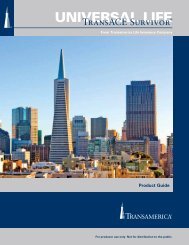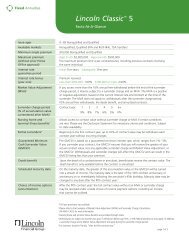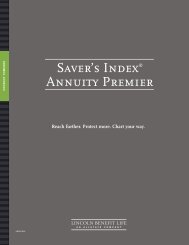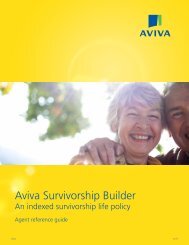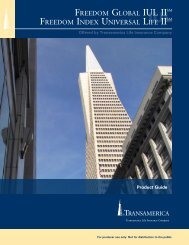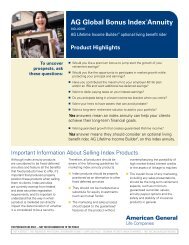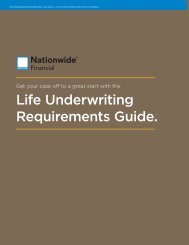TransTerm Product Guide - Mibsga.com
TransTerm Product Guide - Mibsga.com
TransTerm Product Guide - Mibsga.com
Create successful ePaper yourself
Turn your PDF publications into a flip-book with our unique Google optimized e-Paper software.
Universal Life<strong>TransTerm</strong> SMFrom Transamerica Life Insurance Company<strong>Product</strong> <strong>Guide</strong>For producer use only. Not for distribution to the public.
<strong>TransTerm</strong> SM®Table of ContentsPageQuick Facts 3Policy Description 5About <strong>TransTerm</strong> SM 5Policy Design 5No-Lapse Guarantee Endorsement (ACE) 5More About the Policy Threshold 6Quoting <strong>TransTerm</strong> 6Compensation 7Kind Codes 8Underwriting 9Additional Features 9Rate Band Break for Multiple Policies (Stacked Coverage) 9No Maturity Date 10Death Benefit 10Premiums 10Planned Periodic Premiums 10Premium Limitations 11Premium Refunds 11Free-Look Period and Delivery Period 11Free-Look Period 11Delivery Period 11Monthly Deductions (MD) 11Current Monthly Deduction Rates 11Guaranteed Maximum Monthly Deduction Rates 12Policy Charges 12Premium Expense Charge 12Monthly Expense Charge Per Thousand 12Monthly Policy Fee 12Interest Assumptions 12Current Interest Rate 12Guaranteed Minimum Interest Rate 13This product guide provides highlights only.Please see the policy contract for details, including conditions and limitations.t r a n s a m e r i c a | 1
®<strong>TransTerm</strong> SMPolicy Lapse and Grace Period 13Policy Lapse 13Grace Period 13Reinstatements 13Full and Partial Surrenders 14Full Surrender 14Partial Surrenders 14Loans 14Capitalization of Loan Interest 15Loan Repayments 15Policy Changes 15Policy Face Amount Increases 15Policy Face Amount Decreases 15Conversions 15Rewrites 15Underwriting Class Changes 16Information about Federal Tax Laws 16MECs and IRC Section 1035 Exchanges 17Riders and Options 18Accident Indemnity Rider (AI) 18Children’s Insurance Rider (CIR) 18Waiver Provision Rider (WP) 19Accelerated Death Benefit (ADB) 20In<strong>com</strong>e Protection Option (IPO) 20No-Lapse Guarantee Endorsement 20<strong>TransTerm</strong> SM is non-participating, flexible premium universal life insurance issued by Transamerica Life InsuranceCompany, Cedar Rapids, IA 52499. Policy Form Nos. ICC10-410, ICC10-415, ICC10-420, ICC10-425 and ICC10-430respectively. Policy forms and numbers may vary and these policies may not be available in all jurisdictions. Insureds inNew Jersey and Rhode Island are issued certificates through the National Consumer Protection Trust, Group CertificateNos. 2-41050110, 2-41550110, 2-42050110, 2-42550110 and 2-43050110 respectively.2 | <strong>TransTerm</strong> SM <strong>Product</strong> <strong>Guide</strong>
<strong>Product</strong> <strong>Guide</strong>®<strong>TransTerm</strong> SM Quick FactsIssue Ages <strong>TransTerm</strong> 10: 18 to 85(Nearest Birthday) <strong>TransTerm</strong> 15: 18 to 80<strong>TransTerm</strong> 20: 18 to 75<strong>TransTerm</strong> 25: 18 to 70<strong>TransTerm</strong> 30: 18 to 65Underwriting ClassesPreferred Plus Nonsmoker (PP)Preferred Nonsmoker (PNS)Standard Plus Nonsmoker (SP)Standard Nonsmoker (SNS)Preferred Smoker (PS)Standard Smoker (SS)Nonsmoker (N)Smoker (S)Minimum Face Amount $25,000Standard Nonsmoker, Standard Smoker,Nonsmoker and Smoker$100,000All Other ClassesMaturity DateNonePremium Bands Band 1: $ 25,000–$99,999Band 2: $100,000–$249,999Band 3: $250,000–$499,999Band 4: $500,000–$999,999Band 5: $1,000,000 +Premium Payment PeriodNo-Lapse PeriodTo age 111 of the insured.From policy issue to age 111 of the insured.Guaranteed Minimum Interest Rate 3%Death Benefit OptionThreshold PeriodPolicy ThresholdLevel Death BenefitThe period between the Policy Date and age 111 ofthe insured.A number calculated to determine a policy’seligibility for the guaranteed death benefit underthe No-Lapse Guarantee Endorsement.t r a n s a m e r i c a | 3
®<strong>TransTerm</strong> SMThreshold Interest RatePremium Expense ChargeThe interest rate used in the calculation of thePolicy Threshold. It is 3%.7%, on a current basis, of all premiums in all yearsto the insured’s age 111.9%, on a guaranteed basis, of all premiums in allyears to the insured’s age 111.Monthly Expense Charge Per ThousandMonthly Policy FeeMonthly Deduction (MD) RatesSurrender ChargesAvailable RidersCurrent rates are applied from policy issue to theinsured’s age 111. The charges are banded and varyby risk class, smoker/nonsmoker, issue age, sex,duration and product selected.Current fees are banded: $5 per month under$100,000, $2.50 per month for $100,000 andabove, for all years to the insured’s age 111. Zerothereafter. Guaranteed fees are $10 per month forall face amounts for all years to the insured’s age111. Zero thereafter.Current MD rates are charged to the insured’sage 111. Guaranteed MD rates are charged to theinsured’s age 121 and are zero thereafter.Decreasing and are applicable for the lesser of theinitial level premium period or 20 years.n Accident Indemnity Ridern Children’s Insurance Ridern Waiver Provision RiderAdditional Featuresn Accelerated Death Benefit (in approved states) forface amounts of $50,000 and highern In<strong>com</strong>e Protection Option (IPO)n No-Lapse Guarantee Endorsementn Free-Look EndorsementConversionIllustrationConversion is not allowed to or from this product.<strong>TransTerm</strong> is declared non-illustratable.4 | <strong>TransTerm</strong> SM <strong>Product</strong> <strong>Guide</strong>
<strong>Product</strong> <strong>Guide</strong>®Policy DescriptionAbout <strong>TransTerm</strong> SM<strong>TransTerm</strong> is structured to offer term-like initial level premiums for 10, 15, 20, 25 or 30 years. The initiallevel premiums offer affordability similar to term and the universal life policy provides the option tocontinue coverage after the initial level premium period if the policy owner chooses.Premiums are flexible as provided within the universal life contract. The initial level premiumsscheduled to specifically meet the level period chosen must be paid on time as billed. Failure to doso may jeopardize the continuation of the initial level premium schedule. If insufficient premiums arereceived or premiums are received late, then a higher premium may be billed for the following policyyear. The ability to catch up exists, but may require significant additional premium and would notreestablish the initial level premium schedule until the next policy year.Policy Design<strong>TransTerm</strong> is a flexible premium universal life insurance policy which has a lifetime death benefitguarantee. This product utilizes a “shadow account” design known as the Policy Threshold to providelifetime death benefit guarantees. The Policy Threshold is a number that is calculated monthly and it isused to determine whether the No-Lapse Guarantee Endorsement (also known as the Assured CoverageEndorsement) will remain active.At the beginning of each policy month, the Company recalculates the net amount at risk (the differencebetween the death benefit and the accumulation value) and deducts the Monthly Deduction (MD) fromthe policy’s accumulation value. The policy accrues interest daily at Company-declared rates on policyvalues and the Company credits it monthly, at the end of each policy month.Premium payments are flexible and may be made at any time prior to the insured’s age 111, subjectto the minimum and maximum premium requirements as explained in the policy. Beginning at theinsured’s age 111, no further premiums will be billed or accepted and the currently scheduled MonthlyDeductions will cease; however, the guaranteed maximum schedule of MD rates continues to age 121of the insured. The policy will continue to accrue interest on the accumulation value at the declaredinterest rate until age 121 of the insured when the accumulation value will continue to earn interest atthe guaranteed minimum interest rate of 3%. Loans can continue to be taken and interest will continueto accrue on any outstanding loans.No-Lapse Guarantee Endorsement (ACE)The No-Lapse Guarantee Endorsement “guarantees” the policy will remain in force even if the cashvalue is insufficient, provided the conditions of the endorsement continue to be met. The No-LapseGuarantee Endorsement (also known as the ACE Endorsement) alters the definition of when the policyenters the Grace Period. Usually, the policy enters the Grace Period as soon as there is insufficient CashValue to keep the policy in force.From the date the policy is issued and throughout the Threshold Period, a number called the PolicyThreshold is calculated to determine whether the guarantee is “active.” The Threshold Period is thespan of time from the Policy Date to the insured’s age 111. (The Policy Threshold figures do not appearon illustrations, data pages, Annual Statements, or on Grace Period notices.)t r a n s a m e r i c a | 5
®<strong>TransTerm</strong> SMIf the policy cash value is no longer sufficient to continue the policy and the Policy Threshold numberminus any outstanding loans is not less than zero, then the guarantee will be active and the policy willnot enter the Grace Period. If the policy cash value is insufficient and the Policy Threshold minus anyoutstanding loans goes below zero, then the policy and the No-Lapse endorsement will enter theGrace Period.Upon the policy entering the Grace Period, we will give the policy owner 61 days to pay sufficientpremium to keep the policy from lapsing. If the policy owner wants to keep the policy from lapsing,he/she has 61 days to pay additional premium or repay any outstanding policy loan to bring the PolicyThreshold net of any outstanding policy loans up to zero (or more). The policy owner will be told of theamount that is needed to be paid by the end of the 61-day Grace Period.If the Policy Threshold net of any outstanding loans is not brought up to zero within the 61 days, thepolicy will lapse.The ACE Provision will terminate at the first of the following:n The end of the Threshold Period at the insured’s age 111,n Termination of the policy for any reason,n Surrender of the policy or change to paid-up life insurance.More About the Policy ThresholdAs stated earlier, the Policy Threshold is a number calculated to determine the eligibility of a policy forthe death benefit guarantee. As long as the value of the Policy Threshold is zero or greater (net of loans)the ACE Endorsement remains active.The Policy Threshold is a calculation that occurs parallel to the accumulation value calculation. Thisfigure is calculated monthly and is increased by premium payments (net of the Threshold PremiumExpense Charge) paid for the base policy (and any riders) and Threshold Interest and decreased by theThreshold Monthly Charges (Threshold Monthly Premium Charges for the base policy and any riders, theThreshold Monthly Expense Charge and the Threshold Monthly Policy Fee), premium refunds, and partialsurrenders. The Policy Threshold accrues interest at the Threshold Interest Rate of 3.0%. The ThresholdMonthly Charges are deducted from the Policy Threshold at the beginning of each policy month.In the calculation of the Policy Threshold, gross premiums received on or after a monthly policy dateand before the next monthly policy date will be applied as if they were paid on the monthly date, thusproviding the policy owner a full policy month’s “grace” for submitting the premium due.Quoting <strong>TransTerm</strong><strong>TransTerm</strong> is designed to be “non-illustratable” under the NAIC Illustration Regulation. Only guaranteedelements of the contract may be quoted. Signed sales illustrations are not required. In fact, anypresentation showing non-guaranteed elements over a period of years—including a sales illustration—is prohibited during the first policy year. Quotes showing policy guarantees only are available on theTransamerica TransWare ® illustration software.6 | <strong>TransTerm</strong> SM <strong>Product</strong> <strong>Guide</strong>
<strong>Product</strong> <strong>Guide</strong>®The TransWare illustration software will allow you to determine a premium schedule that will maintainthe No-Lapse Guarantee Endorsement on the basis of initial level scheduled premium periods of 10, 15,20, 25 or 30 years. Any changes to the assumptions used will impact the premium needed to maintainthe No-Lapse Guarantee.The “Basic Premium Solve” (default quote) will solve for an initial level scheduled premium based onthe product duration chosen and input items assumed as to any lump sums or 1035 exchange amounts.To clarify, this means that if a lump sum or 1035 exchange amount is assumed in the quote, the initiallevel scheduled premium will be reduced for the entire initial level period.All lump sums or 1035 exchanges will be assumed to be received in the first policy month. The softwarewill not allow delayed lump sums or 1035 exchanges on <strong>TransTerm</strong>.If a “Manual” quote is run, the quote will indicate the duration of any death benefit guarantee.If the policy death benefit is continuing due to the ACE endorsement, the accumulation value and thecash value columns will show zero, while the death benefit column will have the death benefit shownwith an “A” indicator after it, referring to the descriptive paragraph in the <strong>Guide</strong> to the Quote.It is very important to understand that the timely payment of premiums is very importantand has an effect on the No-Lapse Guarantee Endorsement and the continuation of theinitial level scheduled premiums.A reminder: a quote helps show the client how a policy works based on the assumptions specified inthat quote. Numbers reflected therein are not predictive of the policy’s actual future performance.Also, keep in mind that the premium mode quoted must be as close to projected as possible becausethe mode greatly impacts the amount of the premium, policy threshold, and values calculated.When dating to save age, enter the age that you are trying to save. Do not enter the insured’s date ofbirth. Initial premiums are applied as of the Policy Date for the Policy Threshold calculations, so showinga delay is not required. However, any actual accumulation and cash values will reflect the actual date ofreceipt of all premium payments and may be reduced from those quoted.CompensationFirst-year <strong>com</strong>missions are paid on first-year premium paid up to the Target Premium.Renewal <strong>com</strong>missions, if applicable to the <strong>com</strong>pensation schedule in effect, are paid on any premiumsreceived in the first year in excess of the Target Premium and on all premiums received after the first 11policy months.t r a n s a m e r i c a | 7
®<strong>TransTerm</strong> SMKind Codes<strong>TransTerm</strong> SM 10 Base PolicyLevel<strong>TransTerm</strong> SM 20 Base PolicyLevelPreferred Plus 6625Preferred Nonsmoker 6624Preferred Smoker 6623Standard Plus 6622Standard Nonsmoker 6621Standard Smoker 6620RatedNonsmoker 6626Smoker 6627Preferred Plus 6641Preferred Nonsmoker 6640Preferred Smoker 6639Standard Plus 6638Standard Nonsmoker 6637Standard Smoker 6636RatedNonsmoker 6642Smoker 6643<strong>TransTerm</strong> SM 15 Base PolicyLevel<strong>TransTerm</strong> SM 25 Base PolicyLevelPreferred Plus 6633Preferred Nonsmoker 6632Preferred Smoker 6631Standard Plus 6630Standard Nonsmoker 6629Standard Smoker 6628RatedNonsmoker 6634Smoker 6635Preferred Plus 6649Preferred Nonsmoker 6648Preferred Smoker 6647Standard Plus 6646Standard Nonsmoker 6645Standard Smoker 6644RatedNonsmoker 6650Smoker 6651<strong>TransTerm</strong> SM 30 Base PolicyLevelPreferred Plus 6657Preferred Nonsmoker 6656Preferred Smoker 6655Standard Plus 6654Standard Nonsmoker 6653Standard Smoker 6652RatedNonsmoker 6658Smoker 66598 | <strong>TransTerm</strong> SM <strong>Product</strong> <strong>Guide</strong>
<strong>Product</strong> <strong>Guide</strong>®Underwriting<strong>TransTerm</strong> is available for issue based on eight risk classifications: Preferred Plus, Preferred Nonsmoker, PreferredSmoker, Standard Plus, Standard Nonsmoker, Standard Smoker and, for rated cases, Nonsmoker and Smoker.The following table summarizes the classes and where substandard extras may be applied.Underwriting Class Table Ratings or Medical Flat Aviation FlatExtras AllowedExtras AllowedPreferred Plus No NoPreferred Nonsmoker No YesPreferred Smoker No YesStandard Plus No YesStandard Nonsmoker No YesStandard Smoker No YesNonsmoker Yes YesSmoker Yes YesWaiver Provision may be rated Table B or D. Should the Waiver Provision be rated and the base policy is notrated, then the rated Waiver Provision may be added to all risk classes.Additional FeaturesThe following are highlights only. Coverage is subject to all contract provisions. Please consult the contractfor details.Rate Band Break for Multiple Policies (Stacked Coverage)We will give a rate band break (lower rate) in the following situations.1. Same individual applying for two or more <strong>TransTerm</strong> policies.2. The policies are underwritten simultaneously (same evidence of insurability).3. The total face amount of the <strong>com</strong>bined policies is high enough to place them in a higher band (better rate)than if they were a single policy.<strong>TransTerm</strong> 10, 15, 20, 25 and 30 are eligible for band breaks.The TransWare software has an option to quote the band break for multiple policies. The option is available usingthe “Stacked Coverage” button.t r a n s a m e r i c a | 9
®<strong>TransTerm</strong> SMNo Maturity Date*With the improvements in medicine and increased public awareness of health-related issues, longevityhas been increasing. In fact, many clients, particularly those in good health, are now concerned aboutliving beyond traditional life insurance policy age limitations. With this in mind, <strong>TransTerm</strong> does nothave a maturity date. As long as sufficient premium payments are made through the insured’s age111, subject to the minimum and maximum premium requirements outlined in the policy, the deathbenefit can continue for the lifetime of the insured. After the policy reaches the insured’s age 111,the currently scheduled Monthly Deductions stop and no further premium payments are accepted.However, the guaranteed maximum schedule of MD rates continues to the insured’s age 121. The policy’saccumulation value will continue to accrue interest at the declared interest rates uninterrupted until theinsured’s age 121, at which time the policy’s accumulation value will continue to accrue interest at theguaranteed minimum interest rate of 3%, but the policy continues on as before in all other respects.*Transamerica Life Insurance Company and its representatives do not give tax advice. Neither the Internal RevenueCode (IRC) nor the Internal Revenue Service (IRS) has defined life insurance beyond age 100 or addressed the taxeffects of attaining age 100 or the actual or constructive receipt of proceeds at that time or later. Clients should beurged to consult with and rely solely upon their own independent advisors regarding their particular situation.Death BenefitThe beneficiary receives the death benefit. The death benefit is equal to the face amount of the basepolicy, less any outstanding loans, as of the date of death.If the accumulation value times the applicable death benefit factor yields a higher amount (i.e., the policyis in corridor), then the death benefit would be this amount, less any outstanding policy loans, as of thedate of death.If the policy is in force at the insured’s age 111, then the full death benefit (as defined in the contract) willremain unchanged after the insured’s age 111.PremiumsThe <strong>TransTerm</strong> policy has premiums payable for the duration of the Threshold Period. The ThresholdPeriod is from the Policy Date to the insured’s age 111.Premiums may be paid at any time prior to the insured’s age 111. Each premium must be at least $10 andmay not exceed the limits described in the contract in the Premium Limitations provision.Planned Periodic PremiumsOn the application, the policy owner enters a premium amount that corresponds to the initial levelpremium for the product chosen, and the mode of payment. The payment at each mode is called thePlanned Periodic Premium (PPP). The payment modes available are direct annual, semi-annual, quarterlyand PAC semi-annual, quarterly and monthly.All modes are available except there is NO direct monthly.10 | <strong>TransTerm</strong> SM <strong>Product</strong> <strong>Guide</strong>
<strong>Product</strong> <strong>Guide</strong>®Premium LimitationsAfter issue, the minimum premium payment amount is $10.We reserve the right to refund premiums in the following situations:1. If unscheduled premiums in any 12-month period exceed $25,000.2. If the total premium paid during the policy year increases the difference between the death benefitand accumulation value, and the premium exceeds $20 per thousand of face amount and three timesthe monthly deduction for the last policy year.Premium RefundsApart from the “Free-Look” Provision, it is not our normal practice to refund premium payments on policies.It is the policy owner’s responsibility to withhold payments if the policy owner does not wish to pay them.Free-Look Period and Delivery PeriodFree-Look PeriodThe Free-Look Period varies from state to state. For the majority of states, the Free-Look Period is 10days, although different rules may apply to “senior” policy owners or replacement situations. Should theFree-Look Provision be exercised, we will refund any premiums paid.Delivery PeriodThe normal Delivery Period for <strong>TransTerm</strong> is 60 days.Monthly Deductions (MD)Current Monthly Deduction RatesCurrent Monthly Deduction (MD) rates are guaranteed for the first policy year. After the first policy year,the MD rates will never be greater than the guaranteed maximum rates printed in each issued policy.Currently scheduled MDs are taken until the policy reaches the insured’s age 111, then the currentschedule of MD rates stops and no further premium payments are accepted. However, the guaranteedmaximum schedule of MD rates will continue to the insured’s age 121.Each month, the Company subtracts from the accumulation value a Monthly Deduction (MD). The MDrates are applied to the net amount at risk, which is the difference between the death benefit of the policyand the accumulation value at the beginning of each month. Monthly Deduction rates are based on ourexpectations as to future cost factors that include but are not limited to mortality, expenses, interest,persistency, and any applicable federal, state, and local taxes.The Monthly Deduction rates vary based on sex, issue age, duration, risk class, rating, and face amountbands as outlined in the Quick Facts found at the beginning of this guide. The band for which the policyqualifies depends on the base policy face amount or, in the case of Stacked Coverages, the total faceamount of all the “stacked” <strong>TransTerm</strong> policies.t r a n s a m e r i c a | 11
®<strong>TransTerm</strong> SMGuaranteed Maximum Monthly Deduction RatesThe current Monthly Deduction rates are guaranteed for the first policy year. For all nonsmokerunderwriting classes the guaranteed maximum Monthly Deduction rates for policy years 2 and laterare based on 2001 CSO sex-distinct, ultimate, age nearest birthday nonsmoker tables. For smokersthe guaranteed maximum MD rates (after the first policy year) are based on the 2001 CSO sex-distinct,ultimate, age nearest birthday smoker tables. Guaranteed maximum MD rates continue to the insured’sage 121. From attained ages 121 and up, the guaranteed maximum Monthly Deduction rates are zero. Thetable of guaranteed maximum MD rates is included in the policy contract.Policy ChargesPremium Expense ChargeWhen we receive a premium, the Company deducts a percentage of all premiums received as anadministrative charge. The current non-guaranteed administration charge is 7% and the guaranteedmaximum administration charge is 9% for all policy years until the insured’s age 111, when premiums cease.That means that currently 93% of the premium submitted is credited to the policy’s accumulation value.Monthly Expense Charge Per ThousandThe Monthly Expense Charge per Thousand is deducted from policy issue to the insured’s age 111. Thetables of Guaranteed Maximum Monthly Expense Charges per Thousand are included in the policycontract. The current rates are not guaranteed.Monthly Policy FeeThe current Monthly Policy Fee is $5 per month for face amounts less than $100,000 and $2.50 permonth for face amounts $100,000 or greater, for all years to the insured’s age 111. Thereafter, the currentMonthly Policy Fee is zero.The guaranteed maximum Monthly Policy Fee is $10 per month for all face amounts for all years to theinsured’s age 111. Thereafter, the guaranteed Monthly Policy Fee is zero.Interest AssumptionsThe accumulation value accrues interest at the then-current Company-declared interest rates until theinsured’s age 121. Beginning at the insured’s age 121, the accumulation value will earn interest at theguaranteed rate of 3%.Current Interest RateThe current interest rate applicable to the accumulation value is Company-declared. Although the ratedeclared by the Company can change at any time, it can never fall below the guaranteed minimuminterest rate of 3%.12 | <strong>TransTerm</strong> SM <strong>Product</strong> <strong>Guide</strong>
<strong>Product</strong> <strong>Guide</strong>®The rates applicable to any premium payments are dependent on the dates premium payments arereceived in the Administrative Office. Consequently, more than one interest rate may apply to differentportions of the accumulation value at the same time. The policy owner’s annual statement itemizes theapplicable current rate(s).Guaranteed Minimum Interest RateThe guaranteed minimum interest rate is 3%.Policy Lapse and Grace PeriodPolicy Lapse<strong>TransTerm</strong> is a “cash value-based” lapse policy. This means that the policy enters the Grace Period ifat the beginning of any policy month the cash value (less loans) is not sufficient to pay the MonthlyDeductions plus any loan interest due and not paid in cash (unless the No-Lapse Guarantee, also knownas the ACE endorsement, is active) or if after the insured’s age 111 there is insufficient net cash value tocover the loan interest not paid in cash. A Grace Period letter will be sent to the policy owner. If sufficientadditional premium is not received within the Grace Period, the policy will lapse.Grace Period<strong>TransTerm</strong> has a 61-day Grace Period. Unless the No-Lapse Guarantee, also known as the ACEendorsement, is active, if prior to the insured’s age 111 there is insufficient Net Cash Value to paythe Monthly Deduction due plus any loan interest due and not paid in cash, then the policy will enterthe Grace Period. At the end of any 61-day Grace Period, the policy will lapse if the Company doesnot receive sufficient premium during that time. If upon lapse there is net cash value remaining, theCompany will send a surrender check to the policy owner or change the policy to Reduced Paid Up (instates that require this option) for the amount that can be purchased by the net cash value.If after the insured’s age 111, the policy’s accumulation value is not enough to cover any outstanding loaninterest which has not been paid in cash, then the policy will enter the Grace Period. The policy ownerwill be notified and has 61 days to pay enough to provide sufficient accumulation value to cover theinterest due. If the Company does not receive the minimum payment within the Grace Period, the policyand any attached riders will lapse.ReinstatementsReinstatements are allowed within three years after the lapse date provided the policy owner did notsurrender the policy. The reinstatement is subject to the conditions stipulated in the contract, including:n Evidence of insurability satisfactory to us.n The appropriate premium and reinstatement interest of 6% is paid.If there is a loan, the policy owner must repay or reinstate any policy loan that was in existence as of thetermination date, and the <strong>com</strong>pounded loan interest must be paid at the Loan Reinstatement InterestRate of 8%.t r a n s a m e r i c a | 13
®<strong>TransTerm</strong> SMFull and Partial SurrendersThere may be tax consequences. Policy owners should be urged to consult with qualified tax advisorsabout possible tax implications. In general, partial or full surrender of an amount in excess of the policy’sbasis is taxable. If the policy is a MEC, please see section at rear of this guide entitled “MECs and IRCSection 1035 Exchanges.” Partial surrenders will affect the policy value, net cash value, Policy Threshold,and the death benefit.Company-imposed surrender penalties decrease each year and disappear entirely after the lesser ofthe initial level planned premium period or 20th policy anniversary. There are no surrender penalty-freewithdrawals available on <strong>TransTerm</strong>.Full SurrenderThe surrender penalties for <strong>TransTerm</strong> are applicable for the lesser of the initial level premium periodor 20th policy anniversary and decrease each year until they disappear. The amount available for a fullsurrender is the accumulation value as of the surrender date (plus any interest accrued to the date of therequest), minus any surrender penalty, and minus the amount of any outstanding loans.Riders cannot exist without the base UL coverage. If the policy owner requests a full surrender, all riderswill terminate.Partial SurrendersPartial surrenders are withdrawals of cash value that incur a <strong>com</strong>pany-imposed surrender penalty. Theyare allowed after the Free-Look Period has expired. The minimum partial surrender amount is $500. Themaximum amount available for a partial surrender is the accumulation value, minus the amount of anyoutstanding loans, minus three Monthly Deductions, minus the greater of the full surrender penalty or$25. The Accumulation Value, Policy Threshold and the face amount will be reduced by the sum of thepartial surrender and partial surrender penalty. A partial surrender which would reduce the face amountbelow the minimum face amount will not be permitted.LoansLoans are available any time after the Free-Look Period as long as there is sufficient net cash value. Therequest must be made in writing. The maximum amount available for a policy loan is the accumulationvalue minus the greater of two Monthly Deductions or a full surrender penalty, minus the amount of anyoutstanding policy loans, minus any interest on the requested loan to the end of the policy year. Loanswill affect the policy value and net cash value and the death benefit.The loan has a net effective annual loan cost of 2.5%. This spread is the difference between the effectiveannual loan interest rate and the credited interest rate on loaned funds. There is an 8% effective annualloan interest rate charge (7.4% in advance). The loaned value continues to earn interest at 5.5%, resultingin a net effective annual loan cost of 2.5%. The interest rate on the loaned value is credited and<strong>com</strong>pounded monthly.14 | <strong>TransTerm</strong> SM <strong>Product</strong> <strong>Guide</strong>
<strong>Product</strong> <strong>Guide</strong>®As long as the Policy Threshold minus any outstanding loans is not less than zero, the No-Lapseendorsement will remain in force. Should the Policy Threshold minus any outstanding loans be<strong>com</strong>ezero or a negative number, the policy owner will be notified that the endorsement will lapse unlesssufficient premium or loan repayment is received within the 61-day Grace Period.The minimum loan amount is $500.00.Capitalization of Loan InterestIf the policy owner does not pay policy loan interest in cash, we will create a new loan to pay the interest.If there is not enough accumulation value (net of the outstanding loans and net of surrender charges) topay the loan interest due, the policy goes into the Grace Period.Loan RepaymentsThe policy owner may repay any part of a loan at any time. The policy owner must specifically requestthat a payment be applied to repay the loan; otherwise, we will treat it as a premium payment.Policy ChangesPolicy Face Amount IncreasesNo layers or face increases are allowed on <strong>TransTerm</strong>.Policy Face Amount DecreasesThe minimum amount of any policy face amount decrease is $25,000 and may not reduce the policybelow the minimum face amount. A prorated surrender penalty is assessed during the surrender penaltyperiod of the policy. The surrender penalty period for <strong>TransTerm</strong> is the lesser of the initial level premiumperiod or the first 20 policy years. Future Monthly Deductions (and Threshold Monthly Charges) will bebased on the new face amount. Any subsequent surrender penalties will be based on the reduced faceamount, but the surrender durations will still be measured from the original policy date.Decreasing the face is not a material change for purposes of the 7-pay test. However, if the decreaseoccurs within seven years after issue or after a material change, this will result in the retroactiverecalculation of the TAMRA 7-pay limit based on the reduced face amount. This may cause a policy tobe<strong>com</strong>e a Modified Endowment Contract (MEC) if premiums previously paid in the seven-year period failthe 7-pay test.Conversions<strong>TransTerm</strong> is not available for issue under any conversion option or change of plan option.RewritesIf a policy owner requests a “current date change” from another policy to <strong>TransTerm</strong>, full evidence ofinsurability acceptable to us will be required.For UL:Full surrender charges on the other policy’s value will be assessed. First-year <strong>com</strong>pensation will be paidonly on new out-of-pocket premium up to the amount of the increase in the <strong>TransTerm</strong> target premiumover the other policy’s target premium.t r a n s a m e r i c a | 15
®<strong>TransTerm</strong> SMFor Term:First-year <strong>com</strong>pensation will be paid only on new out-of-pocket premium paid up to the increase in the<strong>TransTerm</strong> target premium over the other policy’s annual premium.Note: If the in force term contract is a level premium policy and the policy is on or after the ninth policy anniversary,then full first-year <strong>com</strong>pensation will be paid on the <strong>TransTerm</strong> target premium.If the in force term contract is a YRT premium policy and the policy is on or after the sixth policy anniversary, thenfull first year <strong>com</strong>pensation will be paid on the <strong>TransTerm</strong> target premium.Underwriting Class ChangesIf the insured provides evidence of insurability satisfactory to the Company, we may change the class ofrisk of the policy to a more favorable risk class. This is a <strong>com</strong>pany practice that is subject to change atany time.Such a change in the policy is considered a material change under TAMRA. The Company may alter orterminate its practice of non-contractual changes at any time.After the change, Monthly Deduction rates will be based on the new risk class. Since we require evidenceof insurability, a new Contestability Period will begin; however, the suicide provision will not start anew.Information About Federal Tax LawsIn this guide, references to the IRC mean the Internal Revenue Code of 1986, as amended.Internal Revenue Code Sections 7702 and 7702A are discussed in a limited fashion.Always caution policy owners to seek the advice of a qualified tax counselor.Transamerica Life and its representatives do not give tax advice, nor should any informationcontained herein be construed as tax advice.<strong>TransTerm</strong> satisfies the definition of a life insurance contract using the Cash Value Accumulation Testmethod under IRC Section 7702.The Cash Value Accumulation Test (CVAT) places no tax law limit on the amount of premiums that can bepaid. Therefore, CVAT ac<strong>com</strong>modates clients who have sizable premiums or deposits (for example, withtransfers of cash values from existing policies). There are, however, Company limitations. See the PremiumLimitation section of the guide for details.The CVAT method ensures that a minimum amount is “at risk” between the death benefit and theaccumulation value. Without this prescribed amount at risk, the contract would not qualify as a life insurancecontract for federal in<strong>com</strong>e tax purposes. To <strong>com</strong>ply with the requirements of IRC Section 7702, the CVATversion uses Death Benefit Factors to maintain the required margin between the accumulation value andthe death benefit. Therefore, as needed, the death benefit is increased, causing the death benefit to go into“corridor” to maintain the policy’s qualification as life insurance. When a policy is in corridor, it may result ina larger amount at risk and larger monthly deductions, which leads to lower cash value accumulation.16 | <strong>TransTerm</strong> SM <strong>Product</strong> <strong>Guide</strong>
<strong>Product</strong> <strong>Guide</strong>®MECs and IRC Section 1035 ExchangesIn 1988, Congress added IRC Sec. 7702A, which created a new category of life insurance called a“Modified Endowment Contract” (MEC). Generally speaking, a life insurance policy be<strong>com</strong>es a MECif the premium exceeds the cumulative limit during the first seven years after issue, or during the firstseven years after a material change. New 7-pay limits may be established for the policy as a result ofchanges in policy terms or benefits. A decrease in face amount during the first seven policy years orwithin seven years of a material change may cause the policy to be<strong>com</strong>e a MEC.Under current federal in<strong>com</strong>e tax law, a MEC still continues to earn tax-deferred interest on itsaccumulation value and generally qualifies for in<strong>com</strong>e tax-free distribution of the death benefit to thebeneficiary. However, if a policy be<strong>com</strong>es a MEC, loans, withdrawals, surrenders, distributions, pledges,and assignments in the two years prior to be<strong>com</strong>ing a MEC and thereafter, are treated as distribution ofearnings first and distribution of cost basis last. This means that the policy owner of a MEC would havean immediate in<strong>com</strong>e tax liability for any money received, up to the gain in the contract, as a result ofany of these transactions on an “in<strong>com</strong>e-out-first” basis. In contrast, if a life insurance policy is not aMEC, distributions are first a recovery of basis and then a distribution of in<strong>com</strong>e in the contract. Partialsurrenders and withdrawals are distributions; policy loans, pledges, and assignments are not considereddistributions when taken from a policy that is not a MEC.In addition, if the policy owner is under age 59½ or is not an individual (e.g., a trust), the policyowner may be subject to the additional 10% federal in<strong>com</strong>e tax penalty on the taxable portion of anydistribution. Though MECs can be valuable life insurance contracts, they should probably be avoided ifthe policy owner plans to withdraw policy values at retirement.A MEC contract is not appropriate for policy owners who wish to deposit large sums of money in theearly years with the intent of withdrawing or borrowing the funds in the near future.To prevent a policy from be<strong>com</strong>ing a MEC, the premium submitted in each of the first seven policy yearsafter issue or after a material change cannot exceed the 7-pay limit. To avoid creating a MEC, premiumsmay not be paid in advance. If, for example, the yearly 7-pay limit is $1,000, then the total premiumsubmitted cannot exceed $1,000 by the first anniversary, $2,000 by the second, $3,000 by the third, etc.If $500 is paid in year one, $1,500 could be paid in year two, but not vice versa. To determine the 7-paypremium for a particular case, you will need to run a quote.To calculate whether the life policy resulting from a Section 1035 exchange will be a MEC, take the grossvalue being carried over and multiply it by the appropriate factor shown on the <strong>Guide</strong> to the Quote. If theresult, plus any new premium submitted, is below the 7-pay limit in each of the first seven years and theold contract was not a MEC, the new policy should not be a MEC. TransWare will do this calculation foryou if you fill in the appropriate 1035 exchange figures. If the result is above the 7-pay limit, the policywill not be<strong>com</strong>e a MEC if no premium is paid during the 7-year period.To determine the 7-pay premium for a particular case, you will need to run a quote. A policy that does notbe<strong>com</strong>e a MEC in the first seven policy years can be<strong>com</strong>e a MEC in later years.t r a n s a m e r i c a | 17
®<strong>TransTerm</strong> SMRiders and Options(The following are highlights only. Please consult the actual contract text for details. Coverage is subjectto all terms, conditions, and exclusions contained in the contract. Availability of any rider and/or option issubject to appropriate regulatory approval and requirements.)RidersAccident Indemnity Rider (AI)AI provides for the payment of an additional death benefit if the insured dies as a result of accidentalbodily injury as defined in the policy. Double this additional amount is payable if the accidental bodilyinjury occurs while the insured is a fare-paying passenger on a <strong>com</strong>mon carrier. Death must occur within90 days from the accident and before policy anniversary nearest age 70 of the insured. AI premium isbased on issue age and remains level thereafter. Rates are not based on sex or smoker status.Accident Indemnity is not available on policies rated higher than Table D.Issue Limits:Ages 16–65 (provided the insured is engaged in non-hazardous occupations as determined by theCompany): For face amounts below $200,000, up to 2½ times the face amount to a maximum of$200,000. For face amounts $200,000 and up, the limit is $300,000 or the face amount, whichever is less,for each insured. AI is limited to a maximum of $300,000 per insured for all AEGON <strong>com</strong>panies.Rates:Available at an additional cost reflected in the Monthly Deductions (and the Threshold Monthly Charges)for the policy.Children’s Insurance Rider (CIR)This rider provides life insurance protection for all of the children in the insured’s family. All new childrenare covered automatically by this rider at age 15 days at no additional premium. The rider is purchased ona unit basis. Each unit is equal to $1,000 of level term insurance which expires at the child’s 25th birthday.The rider terminates at the policy anniversary nearest the insured’s 65th birthday.Insurance under this rider may be converted. All conversions will be made at rates then in effect at theattained age, exact birthday of the children insured under this rider. The covered children may converttheir insurance to a permanent policy up to five times the original amount of the term life insurance, butnot more than $50,000, on certain dates specified in the rider. At times other than those specific dates therider coverage can be converted for an amount equal to the rider coverage amount.If the insured dies before the children, the rider will automatically be changed to an individually ownedpaid up term policy.Issue Ages Minimum MaximumInsured 16 years 55 yearsChild 15 days 18 years18 | <strong>TransTerm</strong> SM <strong>Product</strong> <strong>Guide</strong>
<strong>Product</strong> <strong>Guide</strong>®Issue Limit:Minimum—1 unit. Maximum—none; however, the amount of insurance cannot exceed the base policy.The non-medical limit is 20 units for all issue ages.Conversions:Insurance that terminates under the rider may be converted within 31 days to any level-premiumpermanent policy issued by Transamerica Life. The face amount of the permanent policy can be up tofive times the amount of rider coverage but cannot exceed $50,000 (see rider for details).Rates:Rates apply per unit of CIR: Universal Life (monthly deduction)—$ 0.45If Waiver Provision is issued on the base policy, it will cover the CIR without an additional charge.Waiver Provision Rider (WP)In the event of total disability prior to age 60, as defined in the policy, the Monthly Deductions (MDs) andThreshold Monthly Charges will be waived from the beginning of the disability after a six-month waitingperiod for as long as the disability continues. If the disability starts before the insured’s age 60 andcontinues to the insured’s age 65, then the Monthly Deductions and Threshold Monthly Charges will bewaived for all future policy years. If the insured be<strong>com</strong>es disabled after age 60, the MDs and ThresholdMonthly Charges are waived as long as the disability exists but not beyond the latter of the insured’s age65 or the end of the initial level Threshold premium period.Monthly Deductions and Threshold Monthly Charges will not be waived if the disability results directly orindirectly from intentionally self-inflicted injury, from participation in an insurrection, or from war or anyact of war.The Waiver Provision may be issued as Standard Waiver (without any substandard rating), Table B, orTable D only. No other substandard Waiver ratings are allowed. The Waiver Provision does not add valueto the accumulation value. If the base policy has WP, all riders must have it as well.Issue ages:16–55Termination:WP terminates at the anniversary nearest the insured’s age 65, unless under an active claim.Rates:Available at an additional cost reflected in the Monthly Deductions (and the Threshold Monthly Charges)for the policy.t r a n s a m e r i c a | 19
®<strong>TransTerm</strong> SMOptionsAccelerated Death Benefit (ADB)If the insured has a terminal illness (as defined in the contract) diagnosed by a licensed physician after theissue date of the policy and is expected to die within 12 months, the Accelerated Death Benefit will provideadvance death benefits from the life insurance policy. Benefits advanced under this option may be taxable.The ADB is automatically included on all policies with face amounts of $50,000 or more, if the ADB isapproved in the jurisdiction.Limits:The minimum payment is $10,000. The maximum payment is the lesser of $250,000 or 75% of the <strong>com</strong>bineddeath benefit of all policies on the life of the insured minus a portion of any loans and interest due.Rates:Transamerica Life does not charge an additional premium for this option. However, there is anadministrative fee that varies by state for each Accelerated Death Benefit payment.In<strong>com</strong>e Protection Option (IPO)Provides a fixed settlement option wherein the policy owner can select from any <strong>com</strong>bination of threepayout options which include an initial lump at the insured’s death, monthly payments for a specifiedamount for a guaranteed period of time, and a final lump sum at the end of the guaranteed period.Quotes for IPO are supported in TransWare.Limits:n The minimum initial or final lump sum is $10,000. There is no maximum.n The minimum monthly payment is $100. There is no maximum.n The guaranteed period must be between 5 and 25 years.Rates:Transamerica Life does not charge an additional premium for this option.No-Lapse Guarantee EndorsementThis endorsement guarantees the policy will remain in force (if certain policy requirements remainsatisfied) even if the policy’s cash value be<strong>com</strong>es insufficient. (The No-Lapse Guarantee Endorsementis also known as the Assured Coverage Endorsement or the ACE endorsement.) The eligibility of theNo-Lapse Guarantee Endorsement (ACE) is determined by Policy Threshold. As long as the value of thePolicy Threshold is zero or greater (net of loans) the ACE Endorsement remains active.The Threshold Period is from the Policy Date to the policy anniversary nearest the insured’s age 111, theduration the endorsement is in effect.Rates:Transamerica Life does not charge an additional premium for this option.20 | <strong>TransTerm</strong> SM <strong>Product</strong> <strong>Guide</strong>
For producer use only. Not for distribution to the public. OL 2841 1210




